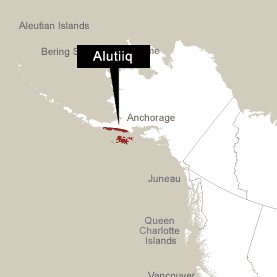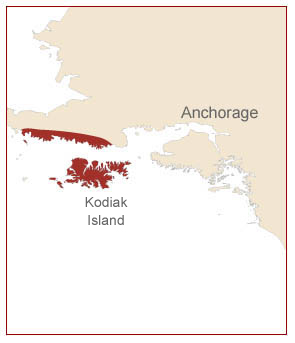
“Alutiiq people are Alaska Natives who live in villages, towns, and cities along the southern coast of Alaska — from Prince William Sound to the Kenai Peninsula, the Alaska Peninsula, and Kodiak Island. The Alutiiq population in this region was about 3,100 in 1990. Other Alutiit reside elsewhere but look back to these shores as their true homeland.
This country of stormy seas and jagged mountains, glaciers, tundra, and forest has been home for 10,000 years. Elders say, “This is the land that we belong to, not the land that belongs to us.”
Throughout the year, residents of Alutiiq villages fish and hunt for salmon, seals, sea lions, caribou, moose, and bear. They also gather berries and many other wild foods that make up an important part of the diet.
Close connection to the land along with language, traditions, values, beliefs and kinship is a strong part of Native identity — of “being Alutiiq.”
Alutiiq heritage extends deep into the past and blends different traditions.
Before Russian conquest in the late 18th century, people lived in dozens of large villages under the leadership of hereditary chiefs. Through masked dances and ceremonies, they communicated with the sensitive and powerful spirits of animals and natural forces. Art, design, and intellectual life were rich and unique, but also influenced by contacts with other Alaska Native cultures. Alutiiq people traded and intermarried with the Unangan of the Aleutian Islands, the Central Yupiit and Dena’ina Athabaskans to the north, and the Tlingit to the east. Oral histories also tell of battles fought over territory and resources.
Russian fur trading companies stayed until 1867. The Alutiiq suffered under Russian rule and the population was severely reduced by smallpox and other diseases. Over time, Russian language, foods, customs, and Orthodox religion became a part of Alutiiq life.
 American rule after 1867 brought new changes. Scandinavian and American immigrants arrived and often married into Alutiiq communities. New industries such as commercial fishing, fox farming, and mining were established. In school, children were allowed to speak only English, which contributed to the decline of the Native language.
American rule after 1867 brought new changes. Scandinavian and American immigrants arrived and often married into Alutiiq communities. New industries such as commercial fishing, fox farming, and mining were established. In school, children were allowed to speak only English, which contributed to the decline of the Native language.
Changing names reflect this history. Before Western contact, people called themselves Sugpiat, “the real people.” Russian fur traders introduced the name “Aleut” which was eventually adopted in Native communities. The Sugpiaq term for Aleut is “Alutiiq.” All three names — Alutiiq, Aleut, and Sugpiaq — are used now, according to personal preference. The Alutiiq language is similar to Central Yup’ik, an Inuit (Eskimo) language, and for this reason anthropologists have called the Alutiit “Pacific Eskimo.”
Today’s Alutiit work in commercial fishing, business, politics, education, and many other fields. Alutiiq communities are linked to each other by new political and economic associations, including regional Native corporations established by the Alaska Native Claims Settlement Act in 1971. Tribal governments are important in the management of local affairs.
Russian Orthodoxy and other Christian faiths have long been central to spiritual life. Today, few people under the age of 60 speak Alutiiq; English is used for everyday communication. Dances and other special occasions are opportunities to wear new versions of Alutiiq traditional clothing.
Despite these many changes, the continuity of tradition is strong. Alutiiq identity is a layering of the old and the new, constantly reshaped by experience.
Arts, language programs, tribal museums, and archaeology are all part of a growing appreciation for this heritage. Today people speak of a new concept — the Alutiiq Nation — with pride.”
-Text copyright of the Smithsonian Museum of Natural History
